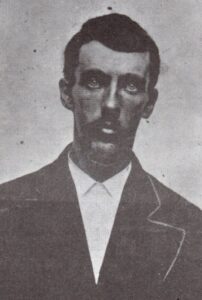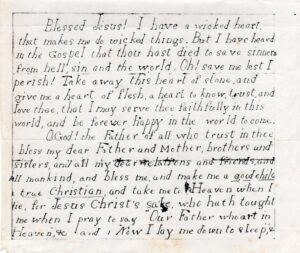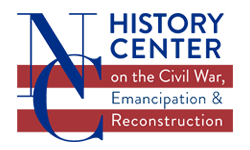Submitted by Don Thomas Simmons; Vetted & edited by Cheri Todd Molter & Kobe M. Brown
 In the Spring of 1862, the soldiers of the 45th North Carolina Infantry were recruited from several different counties in the state. Among those who enlisted was a 5-foot-10-inch tall, 27-year-old farmer whose name was John Lenox Irving. He was from near Whetstone Creek in Rockingham County. John’s photograph revealed him to be a slender man with coal black hair and piercing blue eyes.
In the Spring of 1862, the soldiers of the 45th North Carolina Infantry were recruited from several different counties in the state. Among those who enlisted was a 5-foot-10-inch tall, 27-year-old farmer whose name was John Lenox Irving. He was from near Whetstone Creek in Rockingham County. John’s photograph revealed him to be a slender man with coal black hair and piercing blue eyes.
John Lenox Irving was a first generation American. His father, George Irving, and mother, Jane McDonald Irving, had immigrated from Dumfries Village, Scotland, in July of 1834. They came over on Hector, a ship from Liverpool. After they arrived in the Sates, they traveled to Leaksville, North Carolina, and settled on land near Whetstone Creek that had been purchased by Jane’s late uncle and inherited by Jane’s mother, Janet McDonald.
John Lenox Irving was born in July 1835, about a year after the Irvings settled in North Carolina. According to the 1860 census, the following Irving children still lived in George and Jane’s household at that time: John (25), Georgina (21), Richard (17), Lillie (16), George (13), and Walter age (11).
On March 12,1862, John Lenox Irving enlisted in the Confederate army at Elm Grove, near the crossroads where present-day Stone Mountain Road and Highway 135/311 intersect. John’s company of 100 men called themselves the “Dan River Rangers” since most of the men came from small farms and communities located near the Dan River. From Elm Grove, the group went to Camp Mangum, a training camp near Raleigh, North Carolina, where Company F joined the other nine companies of their regiment. At full strength, there were ten companies totaling over 1,000 men.
After a period of training, Irving’s regiment was sent to Weldon, North Carolina, to guard the vital railroad junction there. The commander of the 45th North Carolina was Colonel Junius Daniel, a graduate of the U.S. Military Academy at West Point and former U. S. Army officer. Daniel, described as a man of “stern integrity and cool courage,” drilled his new regiment incessantly to prepare them for the harsh realities of the battlefield. One member of the regiment recalled they “were upon the drill field upon an average of six to eight hours each day.” In March of 1863, Irving was promoted to corporal. Being designated Corporal indicated trust from officers and other soldiers. A couple of months later, in May, the 45th North Carolina was ordered to join the Army of Northern Virginia at Fredericksburg to serve as reinforcements for its planned offensive in Pennsylvania.
The 45th marched all the way to Gettysburg, Pennsylvania. John’s regiment arrived there around noon on July 1, 1863, and stopped near a wooded hill, known now as Oak Hill, about two miles northwest of Gettysburg. Rumors passed down the column that there had been heavy fighting earlier in the morning. Orders were called out to deploy the line into fighting formation, and the 45th took cover in some woods behind a rise of ground.
Around 1:30 p.m., Gen. Daniel received orders to advance. The long lines of gray-clad infantry advanced like a wave, emerging from the woods out onto open ground. Commands of “Close up!” and “Steady men!” were probably repeated over and over by John, sergeants, and the other officers. To the left, and out of sight, furious musketry fire broke out, a sound that would have sent chills down even the bravest man’s spine. The Dan River Rangers continued to advance. Still, no enemy soldiers were visible, although shells from their artillery came hurtling over with terrifying screams.
When the enemy soldiers came into view, they were in position along a road, in front of a farm, over 100 yards distant. It was reported later that the Union line seemed to explode as they fired their muskets. Many Confederate men were struck, falling wounded or dead along the line. The confusion caused by the surprise attack was too great, and the 45th North Carolina fell back under the cover of a hill to reform their lines and renew their attack. However, the regiment remained under fire from Union artillery, and sometime that afternoon, Corporal John Lenox Irving was wounded and died.
According to The Blog of Gettysburg National Military Park, “Eventually, the 45th, along with many other Confederate units, drove the Yankees from the fields west of Gettysburg. Of the 605 men in the regiment, 63 men were killed, 156 wounded, and an unreported number were missing or captured.”
Although we do not know for certain, we believe that Corporal Irving was buried near the battlefield where the 45th fought. His grave may have been marked, but elapsed time has erased any efforts of identification, and when the bodies on that part of the field were relocated to the South in the early 1870s, John’s body was not identified among them.
Some historians are fond of debating whether the battle at Gettysburg was a turning point in the war; however, there is no question that it was a turning point in the lives of John’s parents, George and Jane Irving, and his brothers and sisters. Furthermore, that battle forever changed the trajectory of the life of Eliza Jane Carter, the woman who had been engaged to John at the time of his death. Eliza lived a long life and never married.
Sometime, after his death, Corp. John L. Irving’s belongings were sent home. According to family lore, his sister, Mrs. “Nene” Georgiana Irving Carter, received his Bible, sword, gun, canteen, and clothing. Enclosed among Corporal Irving’s things was a hand-written prayer. My Mema (grandmother), Kate Irving Thomas, always said that it wasn’t known whether the prayer was composed or copied by John, but it was in his handwriting. It had been written in pencil, mounted on cotton, and wrapped in butcher paper, and was later framed and hung on the wall at her house at Whetstone Creek Road, Shiloh, Stoneville, NC.
 After doing some research, I was able to determine that Irving was not the original author of the prayer. It was written by an English preacher and hymn writer named George Burder. The prayer that John copied came from Burder’s Village Sermons or Sixty-Five Plain Short Discourses on the Principal Doctrines of The Gospel: Intended for the Use of Families, Sunday Schools, or Companies Assembled for Religious Instruction in Country Villages. Here is the excerpt: “Blessed Jesus! I have a wicked heart, that makes me do wicked things. But I have heard in the Gospel that thou hast died to save sinners from hell, sin, and the world. Oh! save me lest I perish! Take away this heart of stone and give me a heart of flesh, a heart to know, trust and love thee, that I may serve thee faithfully in this world, and be forever happy in the world to come.”
After doing some research, I was able to determine that Irving was not the original author of the prayer. It was written by an English preacher and hymn writer named George Burder. The prayer that John copied came from Burder’s Village Sermons or Sixty-Five Plain Short Discourses on the Principal Doctrines of The Gospel: Intended for the Use of Families, Sunday Schools, or Companies Assembled for Religious Instruction in Country Villages. Here is the excerpt: “Blessed Jesus! I have a wicked heart, that makes me do wicked things. But I have heard in the Gospel that thou hast died to save sinners from hell, sin, and the world. Oh! save me lest I perish! Take away this heart of stone and give me a heart of flesh, a heart to know, trust and love thee, that I may serve thee faithfully in this world, and be forever happy in the world to come.”
Just as we don’t know how Irving was killed, we don’t know how he came across that prayer. He may have copied it from Burder’s book at the nearby Wesley Chapel or Elm Grove Church or found the text in the personal libraries of his parents or his grandmother, Janet Lenox McDonald. Or perhaps he got it from a chaplain who provided religious tracts for the troops.
What we do know is that John read the prayer, took it to heart, and wrote it down. After the excerpt of Burder’s prayer, John added a blessing for his “Father and Mother, brothers and sisters…dear relations and friends and all mankind.” He asked God to make him a “good child and true Christian” and to take him to Heaven when he died. He also included the first lines of the Lord’s Prayer and a child’s bedtime prayer. I like to think of him reading this every day, including it in his daily devotions. I like to think of him praying this on the morning of July 1, 1863. John Lenox Irving may have died in Gettysburg that day, but the prayer he wrote down has survived. It serves as an endearing reminder of the young man who remained steadfast in his faith despite the chaos of war and the perils he faced.
Acknowledgements:
- Busby, John and Busby, Travis. 2015. Confederate Casualties at Gettysburg, McFarland &Co. Jefferson, NC, p. 1881
- Hartwig D. Scott, Williams, Rodney P. July 6, 2012. Faces of Gettysburg Lieutenant William E. Harris, Company F., 45th North Carolina Infantry Since Harris and Lenox were in the same company, I used this blog as an outline and reference. http://npsgnmp.wordpress.com This is The Blog of Gettysburg National Park.
- http://evangelical-times.org Blog Evangelical Times Carswell, Roger, George Burder, Founder of the Religious Tract Society, March 2018
- Burder, George, Village Sermons etc., 1, p. 122, Philadelphia, W.W. Woodward
- Watson, Cyrus B. North Carolina Troops 1861-1865 Forty Fifth Regiment, pp. 34-61
- Spring Garden P.O. 28 Feb. 1823. Elm Grove P.O. 21 Sept.1855. http://ncpostalhistory.com
- Pictures, prayer, primary source documents and personal memories were provided by Kate Irving Thomas, niece of John Lenox Irving.
Note: The name Irving without the g is sometimes used. Church, court, census, ships manifest show Irvin and Irving. I have chosen to include the “g”. The name Lenox has only one “n”.
